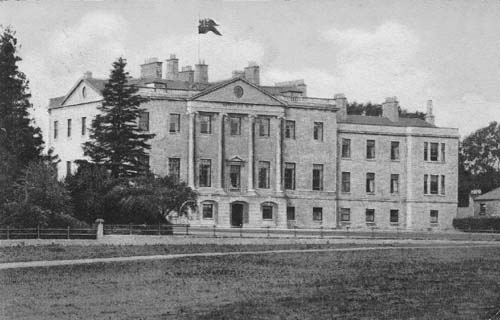At our February meeting Alistair Lack made a return visit to the Society to talk about Country Houses in Oxfordshire. He reminded us that in much of the nineteenth and twentieth centuries significant numbers of large country houses in Britain were demolished, including thirteen in Oxfordshire in the last hundred years. An exhibition illustrating this loss was staged at the V and A museum in 1975.
Alistair began and ended his presentation with Tusmore House situated a few miles north of Bicester. The original Palladian style house was completed in 1766 for William Fermore and passed through several families before it was eventually demolished in 1964. Tusmore has now been resurrected in a modern interpretation by Sir William Whitfield and built for the businessman Wafic Said in 2000 for £30 million.
In North Oxfordshire stands Rousham the delightful 15 acre estate of the Cottrell Dormer family. The original house was built for the Dormer family in the seventeenth century but the house and grounds we see today is the property modified and extended in the eighteenth century under the influence of the distinguished house and garden architect William Kent. The gardens at Rousham are a particular attraction, representing the first phase of English landscape design. Fine sculptures are displayed in the grounds to enhance a circular walk with ever changing vistas.
We are all somewhat familiar with Blenheim Palace, a veritable National Monument, often used to host visiting dignitaries, most recently the American President Donald Trump. The palace has its origins in a national award from Queen Anne to John Churchill who led the British armies to victory over the forces of Louis XIV in European battles notably at the village of Blenheim in Bavaria. Unfortunately the sums of money available were not well specified and this led to great conflict between Churchill’s wife Sarah and his friend John Vanbrugh, the chosen architect of the very large English Baroque building. Eventually Vanbrugh was released and banned from the property, to be replaced by Nicholas Hawksmore.
The impressive grounds at Blenheim were designed by Capability Brown who in his career was responsible for forty grand estates, including eight in Oxfordshire. Not everyone approved and the Cambridge critic Robert Owen said he hoped to die and go to heaven before Brown improved it! Brown’s masterstroke at Blenheim was to create the magnificent lake by damming the river Glyme with the “ most expensive bridge in Britain “ crossing it.
More evidence of lavish expenditure is the £3000 Column of Victory in the grounds and the extensive use of Bath stone, for example in the Orangery. Apparently such stone often went missing from the yard to reappear later in Woodstock townhouses. William Kent also makes an appearance at Blenheim in his design for the Chapel.
Alistair next transported us to North West Oxfordshire and the Jacobean gem of Chastleton House, a National Trust property since 1991. The property was little changed in it’s lifetime and many features remain unaltered in four hundred years to give us a time capsule of Jacobean life. Several fine seventeenth century fireplaces adorn the house, having been commissioned to proclaim the wealth and standing of the then owners. Another gem at Chastleton is Bishop Juxson’s bible, used by him at the execution of Charles1. The grounds were famous for the Croquet Lawn and indeed the rules of the game were written down and formalised at Chastleton in 1866 by Walter Whitmore Jones.
The least visited National Trust House is Ashdown House near Lambourne. This modest but delightful seventeenth century country house or hunting lodge was built by the Earl of Craven for Elizabeth of Bohemia, the “ Winter Queen “ (see History Society talk May 2016). She was the aunt of Charles 11 who was a friend of Craven. Unfortunately she died before she was able to visit the Dutch designed house. It seems to be well worth a visit to swell the N.T. numbers.



